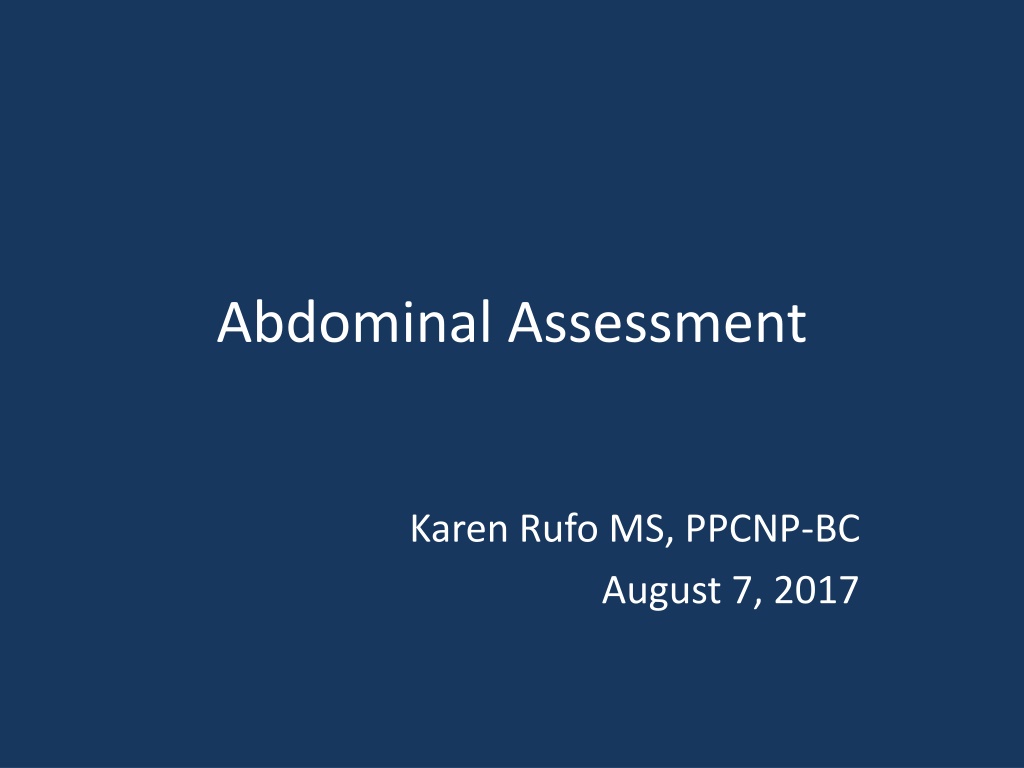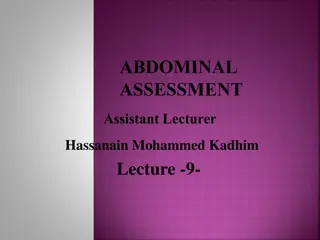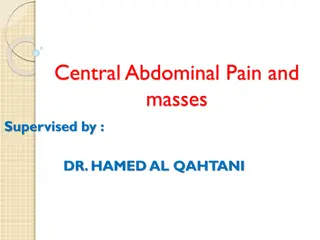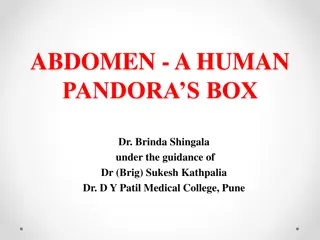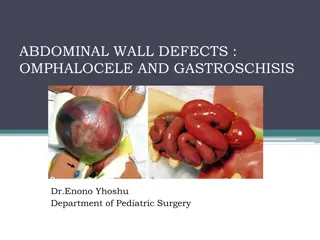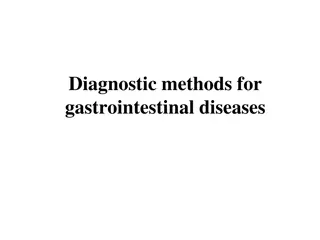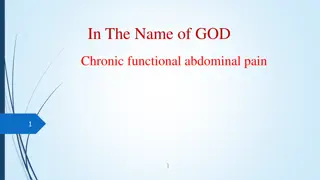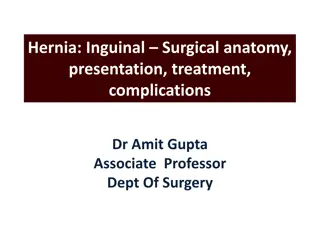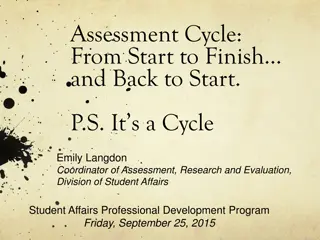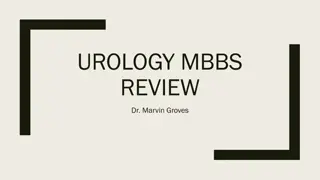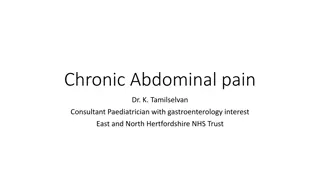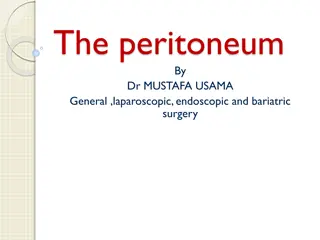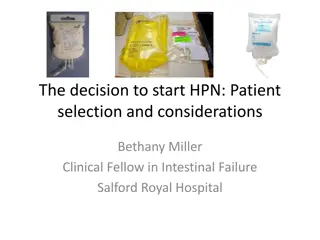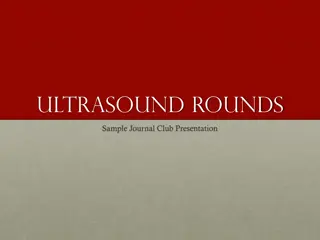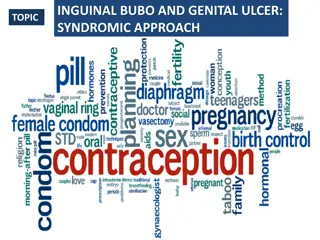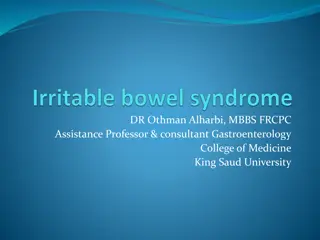Comprehensive Guide to Abdominal Assessment Methods
Learn the critical order of examination for abdominal assessment, including inspection, auscultation, percussion, and palpation. Understand how to assess skin characteristics, symmetry, abdominal muscles, bowel sounds, vascular sounds, organ size, and tenderness. Discover techniques to identify abnormalities like hernias, masses, and rebound tenderness. Cautionary notes on palpation areas to avoid are also highlighted.
Download Presentation

Please find below an Image/Link to download the presentation.
The content on the website is provided AS IS for your information and personal use only. It may not be sold, licensed, or shared on other websites without obtaining consent from the author. Download presentation by click this link. If you encounter any issues during the download, it is possible that the publisher has removed the file from their server.
E N D
Presentation Transcript
Abdominal Assessment Karen Rufo MS, PPCNP-BC August 7, 2017
Order of Exam is Critical! 1. Inspection 2. Auscultation 3. Percussion 4. Palpation
Inspection 1. Skin Characteristics and Color Note any jaundice, redness or cyanosis Note any bruising, scars, straie, rashes or lesions 2. Symmetry Should be evenly rounded Umbilicus should be centrally located Note any distention or bulges 3. Inspect Abdominal Muscles as patient raises their head: Masses Hernia Separation of Muscles
Auscultation o Diaphragm of stethoscope to listen for: Bowel Sounds o Bell the stethoscope to listen for: Bruits
Auscultation o Auscultate before palpation and percussion o Listen for bowel sounds: normal is usually 5-35/minute hypoactive less than 3-5/minute hyperactive greater than 34 per minute no bowel sounds-after 2-5 minutes in all 4 quadrants o Listen for bruits (use bell side of stethoscope)
Listening for Vascular Sounds A R R I I F F
Percussion Assess for tympany and dullness Assess organ size-liver Assess for ascites
Percussion Assess for tympany and dullness Solid Objects: Dull Sound Air-filled: Tympanic Hollow: Resonant
Palpation Palpating for masses, organ size, tenderness Rebound Tenderness: occurs when peritoneum becomes inflamed Press area far away from the tender area and release suddenly. Pain will occur in the area of the disease.
Palpation DO NOT PALPATE A PULSATING MIDLINE ABDOMINAL AREA! Also be cautious with a distended spleen in the LUQ
Peritoneum Visceral Parietal Retroperitoneal Abdominal aorta Kidneys Ureters Pancreas
Abdominal Pain History (PQRSTAAA) P-Place/Location Q-Quality R- Radiates S- Severity T- Timing A- Alleviating Factors A- Aggravating Factors A- Associated Symptoms
Additional GI History 1. Bowel Movements-pattern, size, hard, soft 2. Ingestion of toxins/foreign objects (magnets) 3. Trauma 4. Dietary History 5. PMH 6. Sexual History 7. Family History 8. Travel History 9. Social/Psychiatric History- potential stressors 10. Contact History
Types of Abdominal Pain 1. Visceral 2. Somatic 3. Referred Pain
Visceral Pain o Intermittent, cramp-like pain o Caused by edema or obstruction o Difficult to localize o Usually accompanied by diaphoresis, nausea and vomiting o Examples: early appy, pancreatitis, chole, bowel obstruction or kidney stone
Somatic Pain o Sharp, severe and constant o It s starts and doesn t stop until you intervene o Caused by blood, bacteria or chemicals that leak into the abdominal cavity and cause peritonitis o Student will lie very still, as movement causes pain, may keep legs flexed with knees to chest o May have rebound tenderness o Examples: late stage or ruptured appy, ruptured spleen, traumatic injury or perforated ulcer
Referred Pain Pain that originates in one area but manifests itself in another Examples: o Gallbladder pain radiates to shoulder and mid back o Spleen radiates to left shoulder area
Abdominal Pain o Most common medical cause: gastroenteritis o Most common surgical cause: appendicitis o Acute surgical abdomen: pain come before vomiting o Medical Conditions: vomiting starts first
Causes of Abdominal Pain 2-18 yo Gastroenteritis Constipation Intestinal Obstruction Testicular Torsion Respiratory Illness-PNA Pancreatitis Mesenteric Adenitis Sickle Cell UTI/Pyelonephritis Toxin Ingestion Food Poisoning Trauma Appendicitis Cholecystitis HSP-Henoch-Schnolein Purpura
Causes of Abdominal Pain in Adolescents Trauma Dysmenorrhea Ectopic Pregnancy Testicular Torsion Constipation UTI/Pyelonephritis Appendicitis Cholecystitis Toxin Ingestion Food Poisoning PID Gastroenteritis Ovarian Cysts/Torsion Intestinal Obstruction Pancreatitis Ureteral Colic
Causes of Abdominal Pain from Outside the Abdomen Systemic Thoracic MI Angina Pneumonia Pulmonary Embolism Herniated Thoracic Disk DKA Alcoholic Ketoacidosis Uremia Sickle Cell SLE (lupus) Vasculitis Hyperthyroidism Abdominal Wall Muscle Spasm Hematoma Herpes Zoster Toxic Methanol Poisoning Heavy Metal Toxicity Scorpion Bite Black Widow Bite Infectious Strep Throat Mononucleosis Rocky Mountain Spotted Fever GU Testicular Torsion Renal Colic
Red Flags of Abdominal Pain 1. Bilious Vomiting 2. Bloody Stools or Emesis 3. Night Time Waking with Abdominal Pain 4. Hemodynamic Instability 5. Weight Loss 6. History of Intra-abdominal Surgery 7. Marked abdominal distention with diffuse tympany 8. Abdominal Trauma
Gastroenteritis Inflammation of GI tract caused by an infection Viral infections, (mostly rotavirus):75-90% of infectious diarrhea cases Rotavirus Norovirus Enteric adenovirus Astrovirus Bacterial Cases:10-20% oSalmonella oCampylobacter oEcoli Shigella Yersinia Cdiff Parasites: 5% oGiardia Cryptosporidium
Gastroenteritis Sx: Sx of Dehydration: Extreme thirst Urine-dark, small amounts Dry skin and mouth Sunken eyes/cheeks Diarrhea Abdominal Pain or Cramping Nausea and Vomiting Fever Clammy skin
Gastroenteritis Dx: Clinical Picture/History Stool Culture for prolonged diarrhea Tx: Fluid Replacement Prevention: Wash your hands!!! Food Safety Bottled water when traveling
Johnny is a 10 yo student who enters the clinic complaining of belly pain . He has already had lunch, but he didn t really feel like eating. He points to his umbilicus and rates the pain as a 6. His temperature is 99.9 po. How would you proceed?
1. Complete your assessment including an examination of the throat Send him back to class Call his parent/guardian Instruct parent/guardian of need for further eval with PCP 2. 3. 4. A. 2,3,4 B. 1,2 C. 1,3,4 D 1, 3
Appendicitis Inflammation of the appendix Cause: no clear Can be seen at any age, more common 10-30 yo Sx: anorexia abdominal pain-starts dull umbilical pain, then becomes sharp gravitating to RLQ abdominal tenderness (+ McBurney s sign) fever vomiting may take 4-48 hours to develop
Advanced Assessment for Appendicitis Rovsing Sign-pain in RLQ on left side palpation Psoas Sign- pain in RLQ when right hip hyperextended Obturator Sign- pain in RLQ on internal rotation of flexed right thigh
Obturator Sign Video https://www.youtube.com/watch?v=j V80jcnhNtA
Rosvings Sign Video https://www.youtube.com/watch?v=6I 03eiLO_lU
Psoas Sign Video https://www.youtube.com/watch?v=n 0a0PCwsVQ4
Appendicitis Dx: Clinical Picture Lab Work- elevated WBC, U/A to r/o UTI Imaging: US or CT Scan Treatment: Appendectomy
Which is the most worrisome? If a student ingests: 1. One Magnet 2. One Metallic Object 3. Two Magnets 4. Two Metallic Objects
Magnet Ingestion Journal American Board Family Medicine September-October 2006 vol. 19 no. 5 511-516
Magnet Ingestion Critical to determine how many magnets the student swallowed Single Magnet: low risk Two or more Magnets or a Magnet ingestion along with a metal object: is at risk for bowel necrosis, obstruction and perforation
Magnet Ingestion Time is important- complications can occur within 12 hours-immediate referral to ER Even if student admits to only ingesting one magnet, MD should get Xrays (two views) to verify. Two views are needed as the magnets could be stuck behind one another.
Magnet Ingestion Dx: Self Disclosure Clinical Picture/History X-ray (two views) Sx: May not have symptoms for 12-36 hours Nausea, Vomiting, Abdominal Pain Tx: Depends on Sx, as well as size, shape and # of magnets and/or other metallic objects ingested
Abdominal Trauma Two types of trauma Blunt-MVA, Falls, Assaults Penetrating: Stab wounds, GSW There are grading systems for the severity of the injury to the spleen, liver and kidneys.
Abdominal Trauma Dx: Clinical Picture/History CBC, Metabolic Panel Imaging Studies
CAT (CT) Scan Computed Axial Tomography o Specialized type of X-ray o X-ray tube rotates around person and collects data o Small degree of radiation exposure o Can be done with or without contrast o Very good for boney structures, lung and chest imaging o Relatively quick scan- about 5 minutes o Cheaper than MRI s about half the price o First available in 1971
MRI (Magnetic Resonance Imaging) o Uses magnets and radio waves to create images, no radiation exposure o Very high detail of soft tissues, not good for bones o Also used to spinal cord and brain tumors o Scan takes about 30 minutes o Costs more than a CT Scan o Can t be used in pts with pacers, tattoos and metal implants o First available in 1981
Incarcerated Hernia o Portion of the intestines protrudes through the weakness in abdominal muscles o Inguinal Hernia- occurs in the groin area Sx of Hernia: Bulge in abdomen, groin or scrotum The area is usually painless Sx of Incarcerated Hernia: Severe Pain Nausea, Vomiting No bowel movement
Incarcerated Hernia Dx: Clinical Picture/History Tx: Manual Reduction by MD Surgical Repair Concern: Incarcerated hernia puts child at increased risk for Strangulated hernia-which causes tissue/bowel death and is a surgical emergency
